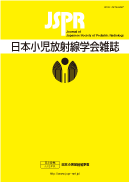Volume 39, Issue 2
Displaying 1-9 of 9 articles from this issue
- |<
- <
- 1
- >
- >|
The topics of radiological diagnosis in pediatric respiratory disease
-
Article type: Special Feature
2023Volume 39Issue 2 Pages 53
Published: 2023
Released on J-STAGE: December 22, 2023
Download PDF (485K) -
Article type: Special Feature
2023Volume 39Issue 2 Pages 54-61
Published: 2023
Released on J-STAGE: December 22, 2023
Download PDF (5913K) Full view HTML -
Article type: Special Feature
2023Volume 39Issue 2 Pages 62-66
Published: 2023
Released on J-STAGE: December 22, 2023
Download PDF (2068K) Full view HTML -
Article type: Special Feature
2023Volume 39Issue 2 Pages 67-74
Published: 2023
Released on J-STAGE: December 22, 2023
Download PDF (4435K) Full view HTML -
Article type: Special Feature
2023Volume 39Issue 2 Pages 75-89
Published: 2023
Released on J-STAGE: December 22, 2023
Download PDF (8467K) Full view HTML -
Article type: Special Feature
2023Volume 39Issue 2 Pages 90-96
Published: 2023
Released on J-STAGE: December 22, 2023
Download PDF (2528K) Full view HTML
Case Report
-
Article type: Case Report
2023Volume 39Issue 2 Pages 97-101
Published: 2023
Released on J-STAGE: December 22, 2023
Download PDF (1077K) Full view HTML -
Article type: Case Report
2023Volume 39Issue 2 Pages 102-106
Published: 2023
Released on J-STAGE: December 22, 2023
Download PDF (867K) Full view HTML
-
2023Volume 39Issue 2 Pages 107
Published: 2023
Released on J-STAGE: December 22, 2023
Download PDF (447K)
- |<
- <
- 1
- >
- >|
